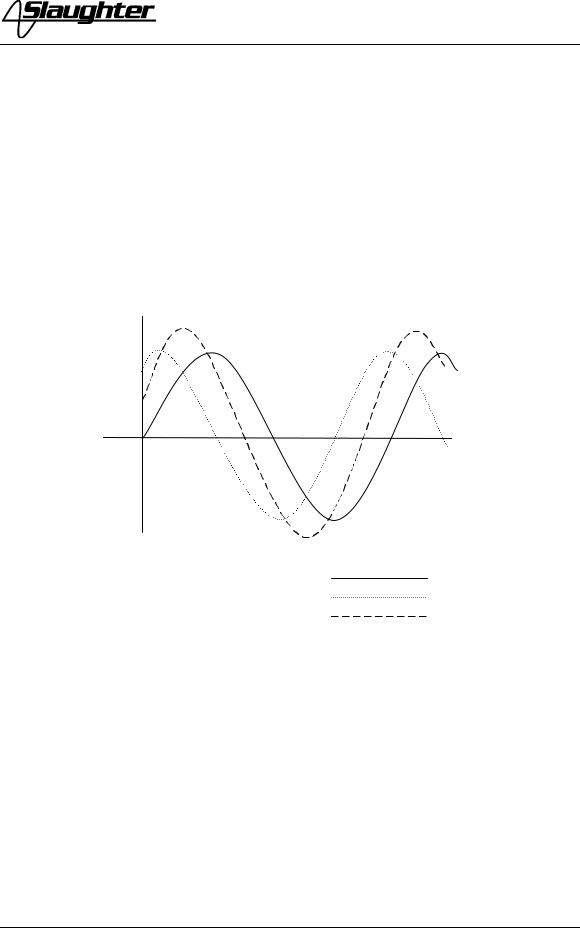Slaughter Company 2550, 2510, 2503, 1305 Service manual

OPERATION AND SERVICE MANUAL
Model 1305, 2503, 2510, 2550
MODEL 1305 (AC ONLY HIPOT)
MODEL 2503 (DC ONLY HIPOT WITH OPTIONAL GROUND CONTINUITY CHECK) MODEL 2510 (AC ONLY HIPOT WITH OPTIONAL GROUND CONTINUITY CHECK)
MODEL 2550 (AC/DC HIPOT WITH OPTIONAL GROUND CONTINUITY CHECK)
SERIAL NUMBER
Models |
© Slaughter Company, Inc., 2007 |
1305/2503 |
28105 N. Keith Drive |
2510/2550 |
Lake Forest, Illinois, 60045-4546 |
U.S.A. |
|
Item 99-10136-01 Ver 1.07 |
Printed October 29, 2007 |
Warranty Policy
Slaughter Company, certifies that the instrument listed in this manual meets or exceeds published manufacturing specifications. This instrument was calibrated using standards that are traceable to the National Institute of Standards and Technology (NIST).
Your new instrument is warranted to be free from defects in workmanship and material for a period of (1) year from date of shipment. You must return the “Owners Registration Card”provided within (15) days from receipt of your instrument.
Slaughter Company recommends that your instrument be calibrated on a twelve-month cycle. A return material authorization (RMA) must be obtained from Slaughter Company. Please contact our Customer Support Center at 1-800-504-0055 to obtain an RMA number. It is important that the instrument is packed in its original container for safe transport. If the original container in not available please contact our customer support center for proper instructions on packaging. Damages sustained as a result of improper packaging will not be honored. Transportation costs for the return of the instrument for warranty service must be prepaid by the customer. Slaughter Company will assume the return freight costs when returning the instrument to the customer. The return method will be at the discretion of Slaughter Company.
Except as provided herein, Slaughter Company makes no warranties to the purchaser of this instrument and all other warranties, express or implied (including, without limitation, merchantability or fitness for a particular purpose) are hereby excluded, disclaimed and waived.
Any non-authorized modifications, tampering or physical damage will void your warranty. Elimination of any connections in the earth grounding system or bypassing any safety systems will void this warranty. This warranty does not cover batteries or accessories not of Slaughter Company manufacture. Parts used must be parts that are recommended by Slaughter Company as an acceptable specified part. Use of non-authorized parts in the repair of this instrument will void the warranty.
TABLE OF CONTENTS |
|
INTRODUCTION ......................................................................................................... |
2 |
INSTALLATION AND SAFETY ................................................................................... |
2 |
SERVICE AND MAINTENANCE ................................................................................. |
9 |
GLOSSARY OF TERMS ........................................................................................... |
11 |
SPECIFICATIONS ..................................................................................................... |
13 |
CONTROLS ................................................................................................................ |
17 |
QUICK START........................................................................................................... |
21 |
SETUP ......................................................................................................................... |
23 |
MODEL 1305 ........................................................................................................... |
23 |
MODELS 2503/2510/2550........................................................................................... |
26 |
FIELD INSTALLATION OF OPTIONS ....................................................................... |
29 |
OPERATION............................................................................................................... |
30 |
MODEL 1305 ........................................................................................................... |
30 |
MODELS 2503/2510/2550........................................................................................... |
31 |
REMOTE INTERFACE FOR MODEL 1305................................................................. |
33 |
REMOTE INTERFACE FOR MODELS 2503/2510/2550 ................................................ |
34 |
OPTIONS .................................................................................................................... |
35 |
CALIBRATION PROCEDURE ................................................................................. |
36 |
PARTS LIST ............................................................................................................... |
37 |
SCHEMATIC INDEX................................................................................................. |
38 |

INTRODUCTION
INTRODUCTION
This section is prepared to assist the user of Slaughter manually operated bench type test equipment with the use, installation, inspection and maintenance of the equipment.
Since any electrical equipment can be hazardous, all procedures described should be conducted by qualified personnel familiar with safety rules applying to electrical equipment and who have been thoroughly instructed as to the nature of the procedure, the hazards involved, and the necessary safety precautions.
Defects and weaknesses in the electrical insulation system must be detected to insure that the product is safe for use by the consumer. In most windings there are two basic types of insulation systems. The ground insulation separates the windings from a magnetic core material or an exposed conductive frame or exterior. The second insulation system is the wire insulation, which in lower voltage windings is typically a thin film coating the wire. These two insulation systems perform different functions in the winding and require different tests to evaluate their integrity. The Dielectric Withstand Test is used to evaluate the ground insulation system.
This test has been described by many names; Hi-pot Test, Dielectric Withstand Test, Insulation Leakage and Breakdown Test, Shorts Check, Ground Check and others. What ever the name, the purpose is to detect failure of the insulation system that separates the current carrying portions of an electrical device from any exposed conductive components.
WARNING For operator safety reasons, and to avoid possible tester damage, 
 the product under test SHOULD NOT BE CONNECTED in any
the product under test SHOULD NOT BE CONNECTED in any
way to the AC power lines.
Typically, it is the responsibility of the manufacturer to establish the proper tests needed for a particular product to insure they comply with all agency requirements.
INSTALLATION AND SAFETY
CAUTION |
For operator |
safety reasons, and to avoid possible tester |
|
damage, the |
product under test SHOULD NOT BE |
CONNECTED in any way to the AC power lines.
When first received, unpack the equipment carefully and inspect for any hidden damage. If damage is evident, keep the carton and file a claim with the carrier.
Packed with all Slaughter equipment is a certificate of conformance, operator’s manual, test leads and any required interface connectors.
2

INTRODUCTION
To check the unit quickly, install any interface connectors, plug the unit into the proper voltage and follow the steps outlined under operating instructions.
If the unit does not operate, contact the factory for instructions.
Of prime consideration and importance in the layout and installation of a test station is to insure the safety both to the operator and any visitors or casual bystanders, invited or otherwise. As a general rule it is suggested that each test area be in a location with minimum distractions and not subject to extremes of temperature and moisture.
One of the more important ways to promote safety is through operator training. Benefits of training are twofold. First, thorough training promotes safety which may significantly reduce injuries on the job. Second, it ensures adequate testing of the product which helps increase product reliability. Both of these can have a positive impact on profits.
An additional consideration in any test station is operator comfort. This is affected by the operator’s position, which includes the chair, table, test equipment, the object under test and the test procedure itself. The chair and work bench or table should be nonconductive and the table as large as possible to allow sufficient room for the test equipment and the object under test. Studies should be made of the test requirements and work habits and steps taken to ensure that any unusual or unnatural motion is not required and to eliminate any repetitive motions that may produce injuries such as carpel tunnel syndrome.
After the equipment has been installed, a careful study should be made of the test station to determine what, if any, safeguards are needed. It is suggested that any electrical test station involving voltages in excess of 42.4 volts peak (approximately 30 volts RMS) should be equipped with safeguards. These should operate both for the protection of the operating personnel and for the protection of casual bystanders. At the minimum, safeguards should prevent the operating personnel or casual bystanders from coming into contact with the test circuit. In the event electrical interlocks of any sort are required, either to insure that guards are in place, or to insure that the operator’s hands are in a safe location, the installer should refer to the proper schematic drawing and install these interlocks in series with the external interlock terminals provided in the tester. All testers may be safety interlocked with series manual or automatic safety switches, relays, etc. as desired. In the simpler units, this is done by inserting such interlocks in the AC supply ahead of the tester. In some units adapter plugs with remote interface controls are provided for this purpose. We will be happy to provide suggestions and schematics for safety interlocking our test equipment.
Any electrical power receptacle utilized to operate this equipment must be a properly grounded three wire receptacle that has been checked for proper polarity.
The test procedure should be well thought out to ensure that it adequately tests the product to the desired criteria but, that the procedure does not require the operator to perform tasks that are unsafe. The product should never be touched during a test and in
3

INTRODUCTION
the case of a grounded part the conductive table or conveyor should not be touched during a test.
Several models of high voltage test equipment are designed with the high voltage output “floating”. There is no ground on either the High side or the Low side of the high voltage transformer. One of the test leads of the HV transformer is considered the Low side due to the winding pattern of the transformer, but it is NOT grounded. This arrangement provides a one type of safety margin to the operator because someone must come in contact with both leads to receive a shock.
Some models of test equipment have one lead of the output grounded or production requirements are such that it is impossible or impractical to test a product in an “ungrounded” configuration. When the tester and the product are grounded, it is important to remember that the operator is also grounded and need only touch the ungrounded lead to receive a shock.
A major consideration in testing products that are “grounded” (touching a conductive conveyor or table) is to insure that the operator or bystanders cannot or will not come in contact with the table or conveyor during a test. Under some product failure conditions, the table or conveyor may become “live”and present a high voltage potential to true earth ground if the table or conveyor is not properly grounded.
It should never be assumed that a conveyor or conductive table is “grounded”just because it is bolted to the floor. A proper ground is one that has been verified to return to the input power line ground (earth ground) with a resistance of less than ½ ohm. This will help eliminate “floating” grounds, ground loops and “phantom” voltages between the object under test and the tester case which is grounded to the power line ground.
The testing of very large items such as recreational vehicles and mobile homes poses special problems because the safety hazards involved are considerably greater than those involved in testing smaller objects.
This is because it is possible under fault conditions for the entire outer skin of the object being tested to become charged to a high voltage. This is particularly bad because these units are so large that the person conducting the test is in no position to observe whether or not any other people are in a potentially dangerous position during the test.
If proper precautions are taken, there will be no hazard, but even so, it is highly desirable that care be taken to isolate the test object when a test is being conducted. Suggested methods of doing this are the use of rope barriers, warning signs, and fully enclosed test areas.
Before conducting a test on these units, care should be taken to see that the frame and skin of the unit are connected to a solid ground, and also that the ground conductor of the electrical system is connected to a solid ground. This will eliminate most test hazards, but
4

INTRODUCTION
bear in mind it is possible for some sections of the skin to have poor electrical connection and that they thereby, can become a potential safety hazard in the event of a fault. This is why isolation of the vehicle during the test is recommended.
Once these safety precautions have been taken and it has been established that the frame and skin are properly grounded, the operator can proceed with the dielectric test.
Good safety practice dictates labeling of hazards properly. Since high voltage testing can be hazardous, the work station should be labeled. Naturally, the location of the label should be carefully selected so that it can be placed in a location that will do the most good.
In some cases, this may be on the test instrument itself, and in others, it may be in a location directly in front of the operator, somewhat removed from the instrument.
A final word about high voltage testers. Generally, commercial high voltage test equipment is not in itself hazardous. The hazards come about when the equipment is improperly used. These testers, when used properly and in a safe manner, can be a check on the quality and reliability of your product. If used incorrectly and without proper consideration for safety, they represent a hazard for both operating personnel and casual bystanders. We strongly recommend proper training for all personnel involved in testing.
High Voltage Testing
High Voltage Testing has historically been the most mis-understood, mis-applied, misinterpreted inspection function in the average factory. Some manufacturers have looked upon the High Voltage Dielectric Withstand test or Hipot test as it is more commonly known, as an extra operation that must be performed to satisfy some agency requirement. Though many times the high voltage test is simply a safety measure, its value in quality control should not be overlooked.
First and foremost, the hipot test is done to ensure the safety of customers by detecting “grounded”or “shorted”products. By applying a high voltage between “live”current carrying parts of the product and the framework which is normally supposed to be “dead,” or well insulated from the “live”parts, the product is “proof tested”against grounds or shorts which at the least might cause inconvenience and at the most can cause fire or injury. During the hipot test, all insulation is abnormally stressed for the duration of the test. Additionally, it is possible to detect “potential”shorts. Consider there is a bare conductor about .015”from the frame. In the factory, the product is clean and new, but after a year or two of service, contaminants, dust, and moisture may cause this gap to bridge at line voltage resulting in a shock hazard to the consumer.
Secondly, hipot testing is done as a quality control measure. Incipient failures in the insulation of any portion of the product, whether due to workmanship, components or
5

INTRODUCTION
materials are detected by the hipot test before the product is shipped out to cause inconvenience, dissatisfaction and expense in the field.
The most often asked questions are, “Is hipot testing destructive?”and “Should I use AC or DC for the hipot test?”
Today’s modern, commercially available high voltage production line testing equipment is generally not destructive. For most consumer product testing, testers have sufficient sensitivity and response time that short circuit currents can be held to non-destructive levels.
The question of AC or DC is best answered by the question, “What do the specs say?” For the production hipot test, agency requirements almost invariably specify an AC test. Generally, AC hipot testing is considered by many to be more stressful to the insulation than DC hipot testing because of the periodic polarity reversal. Some believe AC testing tends to accelerate breakdown due to material flaws. During use, products are more likely to experience AC voltage transients than to experience DC voltage transients. Therefore, AC hipot tests provide more realistic conditions than DC hipot tests.
The next most common question about hipot testing is, “How much voltage should I use?” Again, “What do the specs say?” As a rule-of-thumb, many applications will require 1000 volts plus twice the normal operating voltage for one minute. Increasing the test voltage by 20% usually allows the test time to be reduced to one second. Automotive products will generally specify 500 volts.
Armatures are produced in both a “single insulated” and a “double insulated” configuration. With single insulated armatures, the commutator and windings are insulated from the iron stack and the shaft which, electrically speaking, are common. Double insulated armatures additionally have the iron stack insulated from the shaft. This provides “double insulation”between the current carrying components, the commutator and the windings, and any exposed dead metal components, normally the shaft.
On single insulated armatures, the dielectric withstand test voltage is normally applied between the commutator and the shaft.
Double insulated armatures, however, will normally have a dielectric withstand voltage applied between the commutator and the iron stack and another dielectric withstand voltage between the iron stack and the shaft. If these two voltages are applied simultaneously and the voltage sources are properly phased, a consequential voltage equal to their sum will be applied between the commutator and the shaft.
6

INTRODUCTION
A hipot test attempts to detect or measure phenomena that indicate electrical problems such as leakage, breakdown and arcing.
Leakage is a flow of current. Leakage becomes significant under two conditions. Any increase in resistive leakage is a “red flag”indication that quality in insulating materials used in the device has in some manner deteriorated. Total leakage becomes significant if it reaches such a level that it becomes perceptible to the user of the equipment. UL extensively researched the area of perception threshold and electrical shock. They found that, generally, “women are more sensitive to leakage current than men and a current flow of 0.5 milliamperes or less at 60 hertz does not produce a reaction which is considered to be hazardous to the individual or to those nearby.”
Some leakage exists in any product, though, in many cases, it will be so minute to defy measurement. It exists for two reasons; first leakage current exists simply because no insulating materials are perfect and have infinite resistance. This is generally referred to as resistive leakage and can be calculated from Ohms Law, E=IR where E is the applied voltage, I is current flow in amperes and R is the resistance in ohms. Second, any electrical device, by virtue of the fact that it is made of conductive material with electrical circuits in close proximity, exhibits what can be called an “inherent capacity effect.” This is actually a capacity and, if we apply AC voltage, current will flow. This is generally referred to as capacitive leakage. The equivalent resistive value of the capacitance (Xc) may be calculated from the formula, Xc=1/(2πfC) where Xc is the equivalent resistance in ohms, f is frequency of the applied voltage in hertz and C is the capacitance in farads. The combination of these two components of leakage (figure 1.) is referred to as the total or complex leakage.
I(c)
I(c) = CAPACITIVE CURRENT
I(t) I(r) = RESISTIVE CURRENT
I(t) = TOTAL CURRENT
I(r)
Current Vector
figure 1.
7

INTRODUCTION
The capacitive leakage is an inherent characteristic of the device controlled primarily by design details. The resistive leakage is a characteristic of insulating materials used and the amount of resistive leakage is generally an indication of the quality of the insulation. This is particularly true when identical devices are being comparatively tested. Both capacitive and resistive leakage vary, almost linearly, with the applied test voltage.
In the average electrical device during AC hipot tests, the resistive current flow is normally much smaller than the capacitive current flow, so changes in the resistive current do not have a significant effect on the total current. The capacitive current, however, is out of phase with the resistive current and can be cancelled in the measurement (figure 2.). With this type of test arrangement, the masking effect of the capacitive current is greatly reduced or eliminated and small variations in insulation resistance become detectable.
RESISTIVE CURRENT
CAPACITIVE CURRENT
TOTAL CURRENT
figure 2.
Breakdown is also a flow of current. However the term is usually used to denote an actual insulation failure. It is readily distinguishable from leakage because the current does not vary linearly with the applied voltage, but instead rises suddenly when the critical or breakdown voltage is reached. Often, but not always, arcing is associated with breakdown.
Arcing occurs in solids and liquids as well as gases. Arcing typically involves currents on the order of 0.4 amperes or more and indicates a potentially dangerous breakdown of insulation or abnormal current flows inside a device.
The ability of high voltage test equipment to react to the excessive current flow or failure of the product under test is often referred to as “sensitivity.”
8

INTRODUCTION
For many years, users of high potential (hipot) dielectric testers tolerated considerable sensitivity differences between individual testers. Products rejected by one tester might be accepted by another. If the two testers were distinctly different models or were made by different manufactures, the question of which tester to rely upon was a difficult one. Unfortunately, the tester chosen was sometimes the one that would accept the products.
In a majority of these situations, the real problem was a lack of an acceptable standard for tester sensitivity. Many low cost production line testers in the past were essentially designed as “go/no-go”testers and sensitivity was often whatever was convenient for the manufacturer.
The variance of the sensitivity curves between different manufacturers and different models was a major factor in U.L.’s (Underwriters Laboratories) move to try and standardize production line hipot test equipment sensitivity. These tester performance requirements have come to be commonly known as the “120 K requirement.”
Unless the hipot tester was designed to meet the “120 K”specifications, it is unlikely that it will meet all of the requirements. The tester’ suitability must be verified.
In general, the original U.L. “120 K”specifications require the tester to reject within .5 seconds when connected to an impedance of 120,000 (120 K) ohms at the specified testing voltage. Additionally, the output voltage sign wave tolerance is specified and the output voltage regulation is required to be -0%, +20%.
Various agencies other than U.L. have their own versions of the “120 K” type specifications. As with all testing specifications, the manufacturer must ensure that they are in compliance with the latest testing requirements for their particular product.
SERVICE AND MAINTENANCE
User Service
To prevent electric shock do not remove the instrument cover. There are no user serviceable parts inside. Routine maintenance or cleaning of internal parts is not necessary. Any external cleaning should be done with a clean dry or slightly damp cloth. Avoid the use of cleaning agents or chemicals to prevent any foreign liquid from entering the cabinet through ventilation holes or damaging controls and switches, also some chemicals may damage plastic parts or lettering. Schematics, when provided, are for reference only. Any replacement cables and high voltage components should be acquired directly from Slaughter Company. Refer servicing to a Slaughter Company authorized service center.
SLAUGHTER COMPANY, INC. |
(PHONE: 1 |
(847) 932-3662 |
1 (800) |
504-0055 |
|
28105 N. KEITH DRIVE |
FAX: 1 (847) 932-3665 |
|
LAKE FOREST, IL 60045-4546 U.S.A. |
E-MAIL : support@hipot.com |
|
|
www.hipot.com |
|
9
